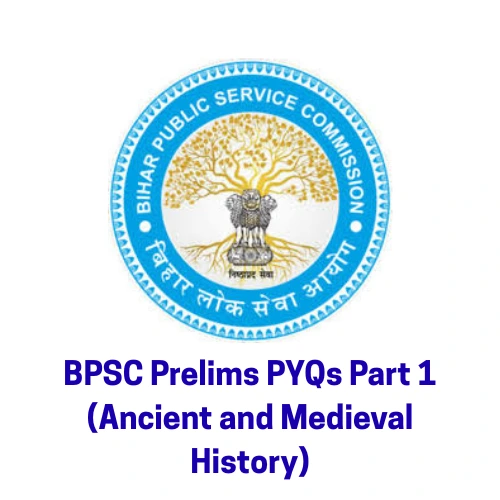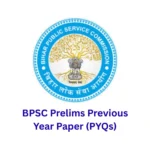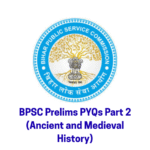BPSC Prelims Previous Year Questions (PYQs) from Ancient and Medieval History form a crucial part of the preparation strategy. These questions usually test candidates on factual knowledge, important dynasties, cultural developments, and major events.
- Ancient History: Questions often cover topics such as Indus Valley Civilization, Vedic Age, Mauryan and Gupta Empires, Buddhism, Jainism, and important inscriptions, coins, and literary sources. Emphasis is also given to Bihar’s historical sites like Nalanda and Vikramshila.
- Medieval History: PYQs focus on Delhi Sultanate, Mughal Empire, regional kingdoms, Bhakti and Sufi movements, art and architecture, and administrative systems. Bihar’s medieval history, including the role of Sher Shah Suri, is frequently highlighted.
BPSC Prelims PYQs Part 1
Q1. During the Delhi Sultanate, the designation ‘Muqaddam or Chaudhuri’ was used for.
a) Village headmen
b) Village accountant
c) Revenue officials
d) None of the above
Answer: a) Village headmen
Q2. The term Zillillah was first used by:
a) Alauddin Khilji
b) Akbar
c) Balban
d) Iltutmish
Answer: c) Balban
Q3. ‘Tarikh-i-Firoz Shahi’ was written by:
a) Shams Siraj Afif
b) Yahya Sarhindi
c) Minhaj Siraj
d) Isami
Answer: a) Shams Siraj Afif
Q4. The oldest civilization in the world is:
a) Indus valley
b) Chinese
c) Egyptian
d) Mesopotamia (Iraq)
Answer: d) Mesopotamia (Iraq)
Q5. Who was the founder of the Maurya Empire ?
a) Bindusara
b) Brihadratha
c) Ashoka
d) Chandragupta Maurya
Answer: d) Chandragupta Maurya
Q6. Which of the following is not the famous centre for Buddhist Learning in Ancient India?
a) Nagpur
b) Valabhi
c) Vikramshila
d) Nalanda
Answer: a) Nagpur
Q7. The script written on Ashoka’s Pillars is:
a) Brahmi
b) Samaritan
c) Pali
d) Sanskrit
Answer: a) Brahmi
Q8. Which of the following is not associated with Chandragupta Maurya?
a) Susima
b) Sanchi
c) Junagadh inscription of Rudradaman
d) Vishnugupta
Answer: b) Sanchi
Q9. Name the major city of the Indus valley civilization that had trade with West Asia.
a) Ropar
b) Lothal
c) Kalibangan
d) None of the above
Answer: b) Lothal
Q10. In India, which of the following city has been declared as the first “City of Literature” by UNESCO?
a) Jabalpur in M.P.
b) Kozhikode in Kerala
c) Kolkata in W.B.
d) Nasik in Maharashtra
Answer: b) Kozhikode in Kerala
BPSC Prelims PYQs Part 1 (Q11 to 20)
Q11. Chitrakoot temple is located in which State of India?
(a) Chhattisgarh
(b) Orissa
(c) Madhya Pradesh
(d) Uttar Pradesh
Answer: (c) Madhya Pradesh
Q12.The temple at Deogarh near Jhansi and the sculptures in the temple at Garhwa near Allahabad are important remains of:
(a) Rashtrakuta art
(b) Gupta art
(c) Maurya art
(d) None of the above
Ans: (b) Gupta art
Q13. Consider the following about the Ajivika sect:
- Makhali Gosala was its most important leader.
- The central idea of the philosophy was “NIYATI” that is fate.
- The discrimination on the basis of caste and class.
- The Ajivikas had regular sabhas for meetings.
Choose the correct answer from the following codes:
(a) 2, 3 and 4 are correct
(b) 1, 2 and 4 are correct
(c) 1 and 4 are correct
(d) More than one of the above
Ans: (b) 1, 2 and 4 are correct
Q14. Consider the following about the King “Praversena”:
- He was the real founder of the Vakataka dynasty.
- His empire extended from Bundelkhand in the north to Hyderabad in South.
- He succeeded his father king Vindhyshakti.
- He is mentioned in Puranas.
Which of the above statements are correct?
(a) 1 and 2 both
(b) 1 and 3 both
(c) 2, 3 and 4
(d) More than one of the above
Ans: (d) More than one of the above
Ancient and Medieval History PYQs
Q15. Which of the following great rulers founded the “Haryak Vansh” in ancient Bihar?
(a) Bimbisara
(b) Brihadrath
(c) Ajatshatru
(d) More than one of the above
Ans: (a) Bimbisara
Q16. Which of the following rulers ruled Assam in the time of Harsha?
(a) Aswad Jahan
(b) Bhaskar Varman
(c) King Dahir
(d) More than one of the above
Ans: (b) Bhaskar Varman
Q17. Match the following in context of Asht Pradhan system of Maratha rule:
| | Official | Department |
| A. | Prime Minister | 1. | Sachiva |
| B. | In charge of Correspondence | 2. | Peshwa |
| C. | Finance Minister | 3. | Samant |
| D. | Foreign Minister | 4. | Amatya |
Choose the correct option:
(a) A-2, B-1, C-4, D-3
(b) A-1, B-2, C-3, D-4
(c) A-3, B-4, C-1, D-2
(d) More than one of the above
Ans: (a) A-2, B-1, C-4, D-3
Q18. Which dynasty ruled Magadh (Bihar) after the Shishunag dynasty?
(a) Maurya Vansh
(b) Sunga Vansh
(c) Nanda Vansh
(d) More than one of the above
Ans: (c) Nanda Vansh
Q19. “Chach Nama” was translated to Persian by.
(a) Nurrudin Muhammad Aufi
(b) Shams-i-Siraj
(c) Muhammad Ali Bin Abu Bakr Kufi
(d) More than one of the above
Ans: (c) Muhammad Ali Bin Abu Bakr Kufi
Q20. Malik Kafur also known as “Hazar Dinari” was bought by whom?
(a) Alauddin Khilji
(b) Ghiyasuddin Tughlaq
(c) Nusrat Khan
(d) More than one of the above
Ans: (c) Nusrat Khan
BPSC Prelims PYQs Part 1 (Q21 to 30)
Q21. Which of the following was the capital of the Chera dynasty?
(a) Kuravur/Karur
(b) Kanchipuram
(c) Madurai
(d) More than one of the above
Ans: (a) Kuravur/Karur
Q22. Which of the following animals was not known to the people of the Indus Valley Civilization?
(a) Bull
(b) Horse
(c) Elephant
(d) None of the above
Ans: (b) Horse
Q23. In Indian art, the construction of ‘Stupa’, ‘Chaitya’ and ‘Vihara’ is related to which of the following?
(a) Ajivika sect
(b) Vaishnava sect
(c) Buddhism
(d) Shaiva sect
Ans: (c) Buddhism
Q24. Consider the following statements:
The arrival of Babur into India led to the
- Introduction of gunpowder in the subcontinent
- Introduction of arch and dome in the region’s architecture
- Establishment of Timurid dynasty in the region
- Introduction of cannons in warfare
Which of the above statements are correct?
(a) Only 1 and 2
(b) 1, 2 and 3
(c) 3 and 4
(d) None of the above
Ans: (c) 3 and 4
Q25.Which among the following ports was called Babul Makka (Gate of Makka) during the Mughal period?
(a) Calicut
(b) Surat
(c) Cambay
(d) Broach
Ans: (b) Surat
Ancient and Medieval History PYQs
Q26. ‘Ashta Pradhan’ was a Council of Ministers
(a) In the Gupta administration
(b) In the Chola administration
(c) In the Maratha administration
(d) In the Vijayanagara administration
Ans: (c) In the Maratha administration
Q27. The painting of ‘Bodhisattva Padmapani’ is located at
(a) Bagh
(b) Ellora
(c) Ajanta
(d) Badami
Ans: (c) Ajanta
Q28. Consider the following statements:
- Fa-Hien was a Chinese pilgrim who visited India during the reign of Harsha.
- Hiuen Tsang was a Chinese Buddhist monk who visited India during the reign of Chandragupta II.
Which of the above statements is/are correct?
(a) Only 1
(b) Only 2
(c) Both 1 and 2
(d) None of the above
Ans: (d) None of the above
Q29. Match List-I with List-II:
| List-I | List-II |
| A. Charaka | 1. Mathematics |
| B. Brahmagupta | 2. Medicine |
| C. Varahamihira | 3. Playwright |
| D. Vishakhadatta | 4. Astrology |
Select the correct answer using the codes given below.
| A | B | C | D |
| (a) | 2 | 1 | 4 | 3 |
| (b) | 1 | 2 | 3 | 4 |
| (c) | 3 | 2 | 4 | 1 |
| (d) | 1 | 4 | 3 | 2 |
Ans: (a) | 2 | 1 | 4 | 3 |
Q30. Who among the following introduced the Persian festival Nowruz in India?
(a) Firuz Shah Tughlaq
(b) Alauddin Khilji
(c) Balban
(d) Iltutmish
Ans: (c) Balban
BPSC Prelims PYQs Part 1 (Q31 to 40)
Q31. Nathpanthis, Siddhas and Yogis made devotional religion popular in
(a) Northern India
(b) Southern India
(c) Eastern India
(d) Western India
Ans: (a) Northern India
Q32. Nitisara, an early book of politics, was written by
(a) Kautilya
(b) Kamandaka
(c) Charaka
(d) None of them
Ans: (b) Kamandaka
Q33. Futuhat-i-Alamgiri was written by
(a) Ishwardas Nagar
(b) Bhimsen
(c) Haridas
(d) None of them
Ans: (a) Ishwardas Nagar
Q34. According to Chinese sources, Meghavarman, the ruler of Sri Lanka, sent a missionary to which of the following Gupta Kings for permission to build a Buddhist temple at Gaya?
(a) Chandragupta I
(b) Samudragupta
(c) Chandragupta II
(d) None of them
Ans: (b) Samudragupta
Ancient and Medieval History PYQs
Q35. In ancient times, the area to the south of the Ganga was known as
(a) Takshashila
(b) Chola
(c) Anarta
(d) More than one of the above
(e) None of the above
Ans: (e) None of the above
Q36. When did the use of iron begin in the Indian subcontinent?
(a) Around 12000 years ago
(b) Around 6000 years ago
(c) Around 9000 years ago
(d) More than one of the above
(e) None of the above
Ans: (e) None of the above
Q37. According to the rock inscription in Sanskrit, composed around the second century CE, Sudarshan Lake, an artificial reservoir was repaired by
(a) Kanishka
(b) Rudradaman
(c) Harsha
(d) More than one of the above
(e) None of the above
Ans: (b) Rudradaman
Q38. The temple of Deogarh near Jhansi and the sculptures in the temple at Garhwa near Allahabad are the important remains of the
(a) Gupta Art
(b) Rashtrakuta Art
(c) Maurya Art
(d) More than one of the above
(e) None of the above
Ans: (a) Gupta Art
Q39. In which of the following battles are the main opponents not correctly stated?
(a) First Battle of Panipat-Babur and Ibrahim Lodi
(b) Second Battle of Panipat-Tipu Sultan and Marathas
(c) Battle of Haldighati-Maharana Pratap and Akbar
(d) More than one of the above
(e) None of the above
Ans: (b) Second Battle of Panipat-Tipu Sultan and Marathas
Q40. During the Delhi Sultanate, the designation, “Muqaddam or Chaudhari”, was used for
(a) Revenue officials
(b) Village Accountants
(c) Village Headman
(d) More than one of the above
(e) None of the above
Ans: (c) Village Headman
BPSC Prelims PYQs Part 1 (Q41 to 47)
Q41. Tabaqat-i-Akbari, which has been sometimes considered more reliable than Abul Fazl’s Akbarnama was written by
(a) Nizamuddin Ahmad
(b) Abdul Hamid Lahori
(c) Gulbadan Begum
(d) More than one of the above
(e) None of the above
Ans: (a) Nizamuddin Ahmad
Q42. Who among the following famous rulers founded a suburban township of Nagalapuram, near Vijayanagara after his mother’s name?
(a) Harihara
(b) Bukka
(c) Krishnadevaraya
(d) More than one of the above
(e) None of the above
Ans: (c) Krishnadevaraya
Q43. Which Gupta ruler assumed the throne after killing his “elder brother”?
(a) Samudragupta
(b) Chandragupta II
(c) Skandgupta
(d) Shri Gupta
(e) None of the above/More than one of the above
Ans: (b) Chandragupta II
Q44. Who laid the foundation of Vardhana Dynasty?
(a) Rajyavardhana
(b) Adityavardhana
(c) Prabhakara Vardhana
(d) Pushyabhuti
(e) None of the above/More than one of the above
Ans: (d) Pushyabhuti
Q45. Who established trade relations with Roman Empire?
(a) Cheras
(b) Western Shakas
(c) Vakatakas
(d) Kushanas
(e) None of the above/More than one of the above
Ans: (d) Kushanas
Q46. The Muslim ruler whose empire regarded as a part of Dar-al-Islam was
(a) Razia
(b) Iltutmish
(c) Nasir-uddin
(d) Balban
(e) None of the above/More than one of the above
Ans: (b) Iltutmish
Q47. Who among the following opposed the power of the Khalifa?
(a) Alauddin Khilji
(b) Muhammad-bin-Tughlaq
(c) Balban
(d) Iltutmish
(e) None of the above/More than one of the above
Ans: (e) None of the above/More than one of the above


